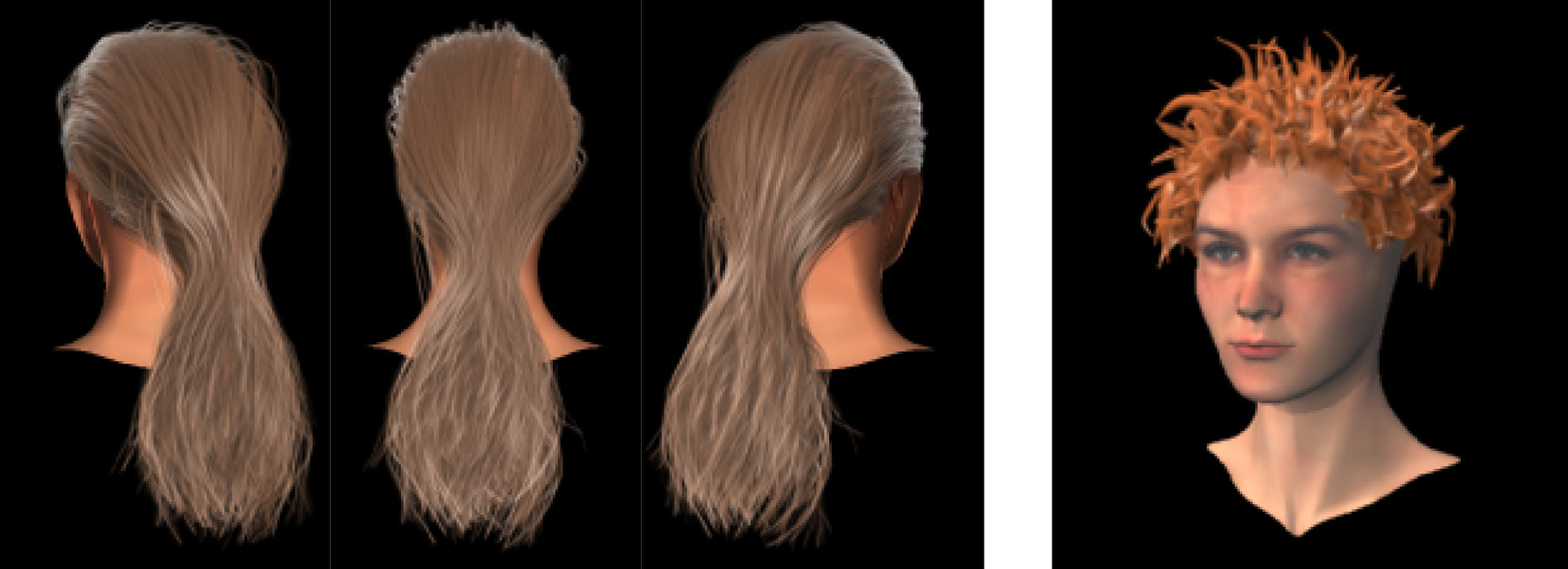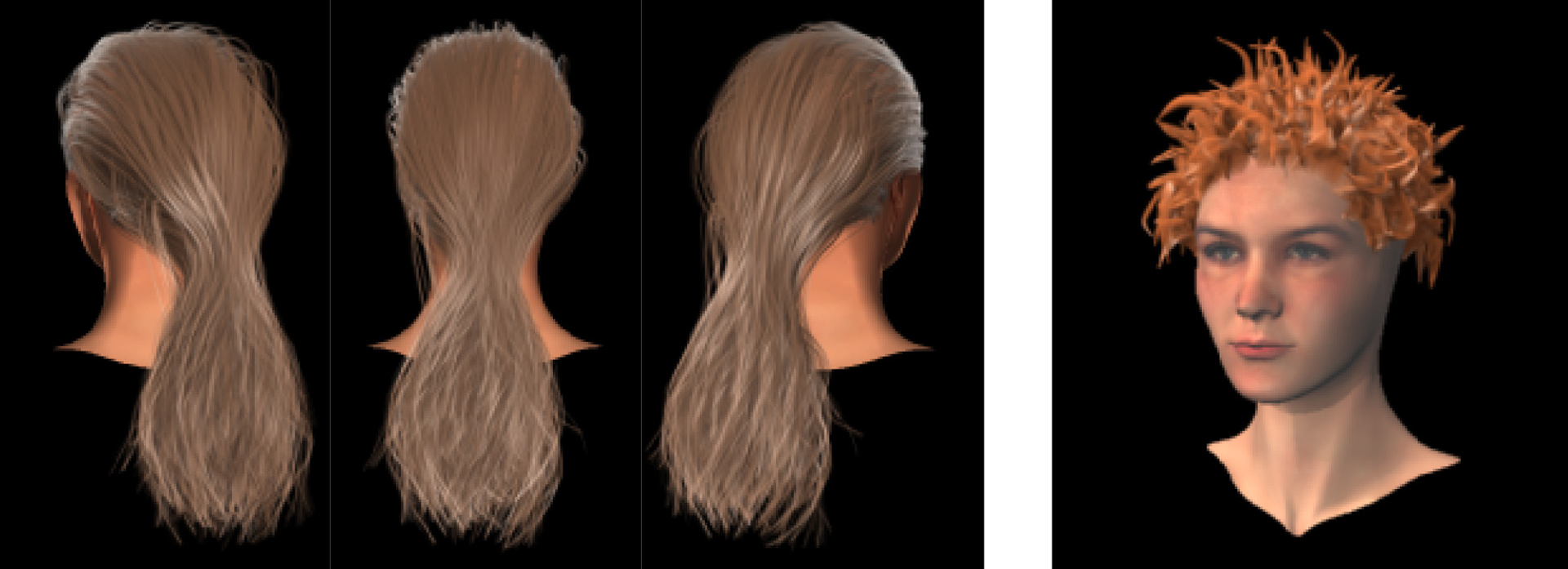“Interactive multiresolution hair modeling and editing”
Conference:
Type(s):
Title:
- Interactive multiresolution hair modeling and editing
Presenter(s)/Author(s):
Abstract:
Human hair modeling is a difficult task. This paper presents a constructive hair modeling system with which users can sculpt a wide variety of hairstyles. Our Multiresolution Hair Modeling (MHM) system is based on the observed tendency of adjacent hair strands to form clusters at multiple scales due to static attraction. In our system, initial hair designs are quickly created with a small set of hair clusters. Refinements at finer levels are achieved by subdividing these initial hair clusters. Users can edit an evolving model at any level of detail, down to a single hair strand. High level editing tools support curling, scaling, and copy/paste, enabling users to rapidly create widely varying hairstyles. Editing ease and model realism are enhanced by efficient hair rendering, shading, antialiasing, and shadowing algorithms.
References:
1. AGUADO, A. S., MONTIEL, E., ZALUSKA, E. 1999. Modeling Generalized Cylinders via Fourier Morphing. ACM Transactions on Graphics. 18(4), 293-315. Google Scholar
2. ANJYO, K., USAMI, Y., AND KURIHARA, T. 1992. A Simple Method for Extracting the Natural Beauty of Hair. In Computer Graphics (Proceedings of ACM SIGGRAPH 92), 26(4), ACM, 111-120. Google Scholar
3. BLOOMENTHAL, J. 1990. Calculation of Reference Frames Along A Space Curve. In A. Glassner, editor, Graphics Gems, Academic Press, 567-571. Google Scholar
4. CHEN, L., SAEYOR, S., DOHI, H., AND ISHIZUKA, M. 1999. A System of 3D Hairstyle Synthesis Based on the Wisp Model. The Visual Computer, 15(4), 159-170.Google Scholar
5. CSURI, C., HAKATHORN, R., PARENT, R., CARLSON, W., AND HOWARD, M. 1979. Towards an Interactive High Visual Complexity Animation System. In Computer Graphics (Proceedings of ACM SIGGRAPH 79), 13(4), ACM, 288-299. Google Scholar
6. DALDEGAN, A., THALMANN, N. M., KURIHARA, T., AND THALMANN, D. 1993. An Integrated System for Modeling, Animating and Rendering Hair. In Computer Graphics Forum (Proceedings of Eurographics 93), 211-221.Google Scholar
7. FALK, R. AND SAND, L. R. (ORGANIZERS) 2001. “Shrek”: The Story Behind The Screen. ACM SIGGRAPH Course Note 19.Google Scholar
8. GOLDMAN, D. 1997. Fake Fur Rendering. In Proceedings of ACM SIGGRAPH 97, ACM Press / ACM SIGGRAPH, New York, 127 – 134. Google Scholar
9. GRABLI, S., SILLION, F. X., MARSCHNER, S. R., AND LENGYEL, J. E. 2002. Image-Based Hair Capture by Inverse Lighting. In Proceedings of Graphics Interface 2002, to appear.Google Scholar
10. HADAP, S. AND THALMANN, N. M. 2000. Interactive Hair Styler Based on Fluid Flow. Eurographics Workshop on Computer Animation and Simulation, 87-100.Google Scholar
11. HADAP, S. AND THALMANN, N. M. 2001. Modeling Dynamic Hair as a Continuum. In Computer Graphics Forum (Proceedings of Eurographics 2001), 329 – 338.Google Scholar
12. HAUSNER, A. 2001. Simulating Decorative Mosaics. In Proceedings of ACM SIGGRAPH 2001, ACM Press / ACM SIGGRAPH, New York, 573-580. Google Scholar
13. KAJIYA, J. AND KAY, T. 1989. Rendering Fur with Three Dimensional Textures. In Computer Graphics (Proceedings of ACM SIGGRAPH 89), 23(4), ACM, 271-280. Google Scholar
14. KIM, M., PARK, E., AND LEE, H. 1994. Modeling and Animation of Generalized Cylinders with Variable Radius Offset Space Curves. The Journal of Visualization and Computer Animation, 5(4), 189-207.Google Scholar
15. KIM, T. AND NEUMANN, U. 2000. A Thin Shell Volume for Modeling Human Hair. In Computer Animation 2000, Philadelphia, IEEE Computer Society, 121-128. Google Scholar
16. KIM, T. AND NEUMANN, U. 2001. Opacity Shadow Maps. Rendering Techniques 2001, Springer, 177-182. Google Scholar
17. LAFRANCE, M. 2001. First Impressions and Hair Impressions. Unpublished manuscript. Yale University, Department of Psychology, New Haven, Connecticut. http://www.physique.com/sn/sn_yale-study2.aspGoogle Scholar
18. LEE, D.-W. AND KO, H.-S. 2001. Natural Hairstyle Modeling and Animation. Graphical Models, 63(2), 67-85. Google Scholar
19. LENGYEL, J. E. 2000. Realtime Fur. Rendering Techniques 2000, Springer, 243-256.Google Scholar
20. LENGYEL, J. E., PRAUN, E., FINKELSTEIN, A., AND HOPPE, H. 2001. Real-Time Fur over Arbitrary Surfaces. ACM Symposium on Interactive 3D Techniques 2001, 227-232. Google Scholar
21. LEVOY, M. AND WHITTED, T. 1985. The Use of Points as a Display Primitive. Technical Report 85-022, Computer Science Department, University of North Carolina at Chapel Hill, January.Google Scholar
22. LOKOVIC, T. AND VEACH, E. 2000. Deep Shadow Maps, In Proceedings of SIGGRAPH 2000, ACM, New York, 385-392. Google Scholar
23. MAUCH, S. 2000. A Fast Algorithm for Computing the Closest Point and Distance Transform. Submitted for publication in the Jounral of SIAM SISC. http://www.acm.caltech.edu/~seanm/software/cpt/cpt.pdfGoogle Scholar
24. MCREYNOLDS, T. (Organizer) 1997. Programming with OpenGL: Advanced Techniques, ACM SIGGRAPH Course Note 11.Google Scholar
25. NEYRET, F. 1997. Modeling, Animating, and Rendering Complex Scenes Using Volumetric Textures. IEEE Transaction on Visualization and Computer Graphics, 4(1), 55-70. Google Scholar
26. O’BRIEN, D., FISHER, S., AND LIN M. 2001. Automatic Simplification of Particle System. In Computer Animation 2001, Seoul, Korea, IEEE Computer Society, 210-219.Google Scholar
27. PARKE, F. AND WATERS, K. 1996. Computer Facial Animation. A K Peters. Google Scholar
28. PLANTE, E., CANI, M.-P., AND POULIN, P. 2001. A Layered Wisp Model for Simulating Interactions Inside Long Hair. Eurographics Workshop on Computer Animation and Simulation 2001, 139-148. Google Scholar
29. ROSENBLUM, R., CARLSON, W., AND TRIPP E. 1991. Simulating the Structure and Dynamics of Human Hair: Modeling, Rendering and Animation. The Journal of Visualization and Computer Animation, 2(4), 141-148.Google Scholar
30. SINGH, K. AND FIUME, E. 1998. Wires: A Geometric Deformation Technique. In Proceedings of ACM SIGGRAPH 98, ACM, New York, 405 – 415. Google Scholar
31. STOLLNITZ, E. AND DEROSE, T. D. AND SALESIN, D. H. 1996. Wavelets for Computer Graphics. Morgan Kaufmann. Google Scholar
32. THALMANN, N. M. AND HADAP, S. 2000. State of the Art in Hair Simulation. International Workshop on Human Modeling and Animation, Korea Computer Graphics Society, 3-9.Google Scholar
33. TURK, G. 1991. Generating Textures on Arbitrary Surface Using Reaction Diffusion. In Computer Graphics (Proceedings of ACM SIGGRAPH 91), 21(4), 289-298. Google Scholar
34. WATANABE, Y. AND SUENAGA, Y. 1992. A Trigonal Prism-Based Method for Hair Image Generation. IEEE Computer Graphics and Application, 12(1), 47-53. Google Scholar
35. XU, Z. AND YANG, X. D. 2001. V-HairStudio: An Interactive Tool for Hair Design. IEEE Computer Graphics and Applications, 21(3), 36-43. Google Scholar
36. YANG, X. D., XU, Z., YANG J., AND WANG, T. 2000. The Cluster Hair Model. Graphical Models, 62(2), 85-103. Google Scholar





